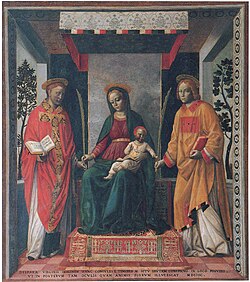Faustinus and Jovita
Saints Jovita and Faustinus | |
|---|---|
 Virgin Mary and Christ Child with Saints Jovita and Faustinus, by Vincenzo Foppa. | |
| Martyrs | |
| Born | Brescia |
| Died | 120 AD Brescia |
| Venerated in | Catholic Church Eastern Orthodox Church |
| Major shrine | Relics at Rome, Bologna, Verona, Brescia, Pietradefusi |
| Feast | 15 February |
| Attributes | depicted as two knightly brothers holding the palms of martyrdom. Sometimes only Jovita is shown, richly dressed and on horseback; an angel may be shown saving them from drowning; sometimes shown with Faustinus of Brescia |
| Patronage | Brescia |
Jovita and Faustinus were said to be Christian martyrs under Hadrian. Their traditional date of death is 120. They are patron saints of Brescia. Faustinus is the patron saint of Pietradefusi.
Traditional vita
[edit]Tradition states that they were members of a noble family of Brescia in Lombardy (northern Italy). Jovinus, the older brother, was a preacher; Faustinus, a deacon. For their fearless preaching of the Gospel, they were arraigned before the Roman Emperor Hadrian, who at Brescia, Rome and Naples, subjected them to frightful torments, after which they were beheaded at Brescia in the year 120. That is the date accepted by the Bollandists, while the historian Paul Allard (Histoire des Persécutions pendant les Deux Premiers Siècles, Paris, 1885) gives the year as 118.[1]
Their Acts were compiled by Faustinus of Brescia, a bishop of Brescia, said to be a descendant.[2]
Veneration
[edit]The many so-called "Acts" are predominantly the fancy of legend. The Jesuit Fedele Savio questioned nearly every detail handed down, other than that they had been martyred. This is amply attested by their inclusion in so many of the early martyrologies and their extraordinary cult in their native city, where from time immemorial they have been the chief patrons.[1] Savio emphasizes that the saints are not to be confused with the fabulous figures in the Acts.
It is believed that they were martyred at a site that either was, or later became, a Roman cemetery. A church was built there called Santi Faustino e Giovita ad sanguinem. Its dedication was later changed to Saint Afra. (Saint Afra's was destroyed during the bombing of World War II).[3]
Their common feast day on 15 February, the traditional date of their martyrdom, was inserted into the General Roman Calendar. It was removed in 1969, because their "Acts are completely fabulous, treating Jovita as a preacher, although she was a woman and a man was Faustinus."[4] The two saints remain listed in the Roman Martyrology, the official, though professedly incomplete, list of the saints recognized by the Catholic Church.[5] The cities of Rome, Bologna, Verona, Pietradefusi and Malečnik share with Brescia possession of their relics.
Cultural legacy
[edit]A lake partially in the town of St. Leo, Florida has been called Lake Jovita since its discovery by Judge Edmund F. Dunne on February 15, 1882. The nearby community of San Antonio changed its name to Lake Jovita in 1927 before reverting in 1933.[6][7]
References
[edit]- ^ a b Murphy, John F.X. "Sts. Faustinus and Jovita." The Catholic Encyclopedia Vol. 6. New York: Robert Appleton Company, 1909. 1 November 2021
 This article incorporates text from this source, which is in the public domain.
This article incorporates text from this source, which is in the public domain.
- ^ Monks of Ramsgate. "Faustinus". Book of Saints 1921. CatholicSaints.Info. 26 February 2013
 This article incorporates text from this source, which is in the public domain.
This article incorporates text from this source, which is in the public domain.
- ^ Richardson, Jessica N., "Through Water and Stone: The Brescia Sarcophagus Crossing of the Red Sea", Exodus: Border Crossings in Jewish, Christian and Islamic Texts and Images (Annette Hoffmann, ed.) Germany, De Gruyter, 2020. p. 53 ISBN 9783110618549
- ^ Calendarium Romanum, Libreria Editrice Vaticana (1969), p. 117
- ^ Martyrologium Romanum (Libreria Editrice Vaticana 2001 ISBN 978-88-209-7210-3), p. 142
- ^ Horgan, James J. (1990). Pioneer College: The Centennial History of Saint Leo College, Saint Leo Abbey, and Holy Name Priory. Saint Leo, FL. Saint Leo College Press. ISBN 978-0-945759-01-0
- ^ Jeffares, Carol (April 30, 1988). "Communities changed names to fit new times". Tampa Tribune. p. 2D. Retrieved December 3, 2017.
![]() This article incorporates text from a publication now in the public domain: Herbermann, Charles, ed. (1913). "Sts. Faustinus and Jovita". Catholic Encyclopedia. New York: Robert Appleton Company.
This article incorporates text from a publication now in the public domain: Herbermann, Charles, ed. (1913). "Sts. Faustinus and Jovita". Catholic Encyclopedia. New York: Robert Appleton Company.
Sources and external links
[edit]- Faustinus at Patron Saints Index
- Saint of the Day, February 15: Jovita and Faustinus Archived 2011-04-23 at the Wayback Machine at SaintPatrickDC.org
- (in Italian) San Faustino
Text is available under the CC BY-SA 4.0 license; additional terms may apply.
Images, videos and audio are available under their respective licenses.
